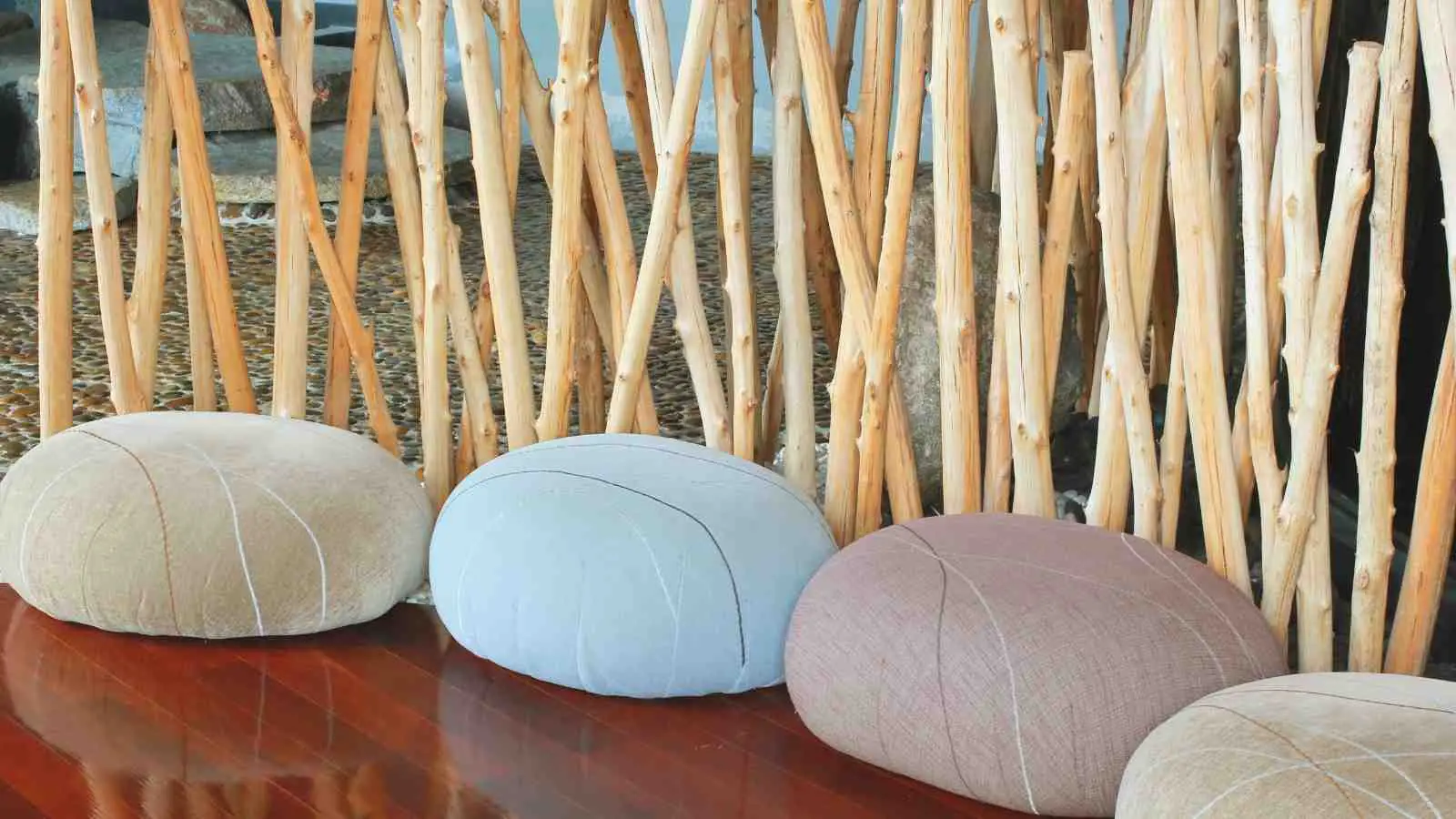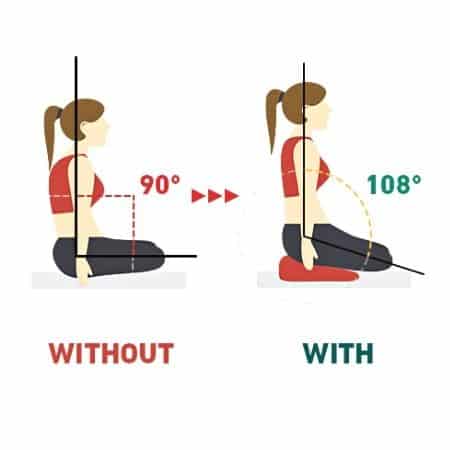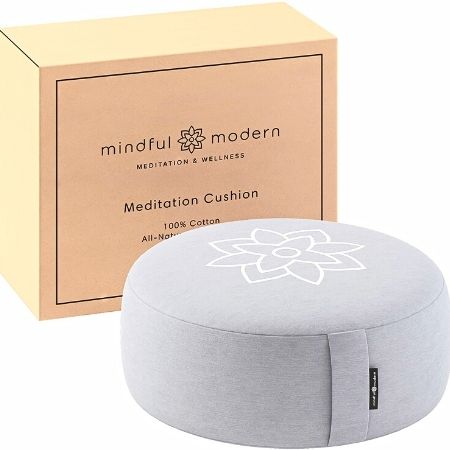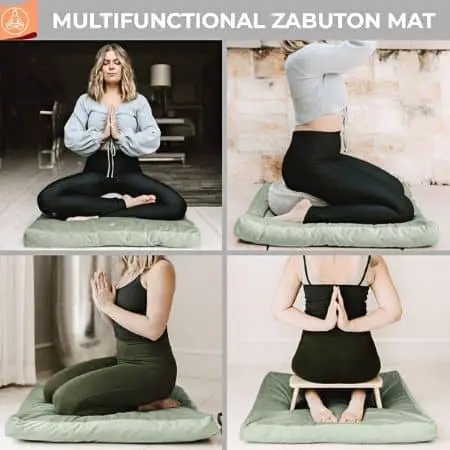Meditation is a practice that has been around for centuries and is still utilized by many today. With the everyday stressors of life such as work, studies, family – which can lead to negative mindsets- meditation is the preferred method for dealing with these stressors now more than ever before. Also, it is known that unwanted thoughts and anxieties can be proactively improved with meditation.
There are many ways one can go about meditating. For example, experiencing different meditation types, whether while lying down (Yoga Nidra meditation) or sitting on the meditation pillow.
Using a meditation cushion while meditating is an excellent way to start. While it seems pretty obvious that having a meditation pillow under while you are sitting on the floor makes you more comfortable, let’s see what science has to say about it.
According to science, there are many reasons you would want to add a meditation pillow to your practice, and it all starts with finding the right one for you! Science has shown that a meditation pillow can significantly increase your comfort and focus during meditation practice.
Using A Meditation Pillow Can Improve Your Posture
From special seating cushions to commercialized back braces, many different devices have claimed to be able to improve your posture, so it’s hard to deny the fact that posture is quite important in everything you do – including meditation. Whether you meditate regularly or not, the pain of sitting cross-legged on a bare floor is quite familiar to many new practitioners of this mental skill.
Think about it. When you’re sitting on the floor, the pressure from your feet jabs into your inner thighs, and your joints being to tense. You might even start to feel numbness in your legs, feet, or bottom! This is no fun for anyone and can disrupt the purpose of meditation – finding peace and comfort in the present moment.
Not only can poor posture interrupt your meditation practice, but over time it can also lead to back problems like sciatica, not to mention chronic pain and discomfort. Having a high-quality meditation pillow ensures that your posture is maintained properly.
Posture and Meditation
Yogis will tell you that correct posture is critical for effective meditation. However, you need to be comfortable so that you can meet your ultimate objective. Meditation should be done in a position that already comes naturally to you. You should be in a position where you can gently shift your body to correct posture throughout your meditation session without disrupting your train of thought.
Because a meditation pillow is slightly raised above the floor, you are forced to maintain a proper posture by keeping your back straight, and the rest of your lower body tilted forward. When using a meditation pillow, you are less likely to slouch and meditate in a position that may leave you aching afterward.
A Meditation Pillow Alleviates Stress on the Body
By maintaining good posture while meditating, the stress on other parts of your body will be relieved. Besides clearing your mind, relaxing your muscles and skeletal system is a large part of the meditation practice. Regardless of the position, sitting puts the most stress on the lower body, including the hips, legs, and ankles.
If you take an even more in-depth look, this affects two important bone structures:
- The pelvis
- The spine
A healthy spine is one that maintains its definitive shape with a slight curve, known as S-shape. When S-shape is disrupted by activities such as bending over, slouching, and sitting on a hard surface, this can cause much pain and discomfort. When you combine a poorly aligned spine with an unsupported pelvis, you have a poorly maintained meditation posture.
The spine has four natural curves—two convex curves and two concave curves. When you meditate while sitting on a hard surface, your pelvis and spine are unsupported, and the pressure on these areas of your body—as well as your legs—begins to weigh heavily.
When you use a meditation pillow, your pelvis is elevated off the ground, relieving the pressure on your legs, knees, and ankles. Once you can alleviate this stress on your body, you can lessen the stress on your mind. Maintaining stillness in the body is just one aspect of meditation. Still, if you are not comfortable, you disrupt the remaining aspects of maintaining the stillness of the mind and spirit.
Meditation Pillows Are Excellent for Beginners
If you’re just starting to meditate, introducing a meditation pillow into your routine is the perfect opportunity to improve your experience. Meditating in a sitting position is one of the first beginner positions you will learn as you work to improve upon your technique.
Before you can determine which meditation methods work best for you, you will need to learn how to sit correctly. As a beginner, it may be challenging to find the sitting position that works best for you. Even as you become more advanced, you still may struggle with this issue because it is relatively common.
For this reason, it’s essential to adjust your body accordingly until you find a sitting position that:
- Feels comfortable
- Supports a good posture
- Is beneficial to your meditation routine
Research conducted by scientists at the National Institutes of Health (NIH) found truth in the claims that meditation can improve overall performance and decrease the need for sleep. It also found that the use of a supportive cushion while meditating can improve the meditation experience as well as provide posture support.
Meditation Pillows Can Enhance Your Meditation Routine
If you are someone who practices meditation, you are undoubtedly aware that it is in your best interest to enhance your routine in any way you can. This can include lighting your favorite candle or incense, playing soft music in the background, or perhaps sitting on a meditation pillow. All are great ways to make sure you’re getting the most out of each session.
The better your meditation goes, the more you will benefit from it. The science behind how meditation improves your daily life isn’t difficult to understand, either. In fact, it’s a no brainer!
The practice of meditation has been proven to affect your life in the following ways:
- Improve your mood
- Reduce your risk of depression and anxiety
- Promote positivity in your life
Getting more out of your meditation routines also means that you’ll be more willing to—and more interested in—meditating consistently. The more consistently you meditate, the more quickly you will be able to sink into a meditative state.
A Meditation Pillow Provides More Comfort
Meditating while sitting, regardless of how you do it, will always involve sitting on your rear. Not only does the added pressure of sitting on your rear in the absence of a cushion makes it an unpleasant experience (especially when sitting on the floor), but it also makes meditating uncomfortable.
Comfort is a very important part of mediation. As mentioned before, meditating while uncomfortable usually means that you cannot reach a true meditative state. When you sit to meditate, you are already concentrating on maintaining your posture, clearing your mind, and steadying your breathing. The last thing you need is the added stress of trying to get comfortable.
Using a meditation pillow to help you find comfort during sitting meditation can create a better sense of relaxation. It can also increase your chances of reaching a meditative trance or enlightened state during meditation a little faster.
Trying Different Positions Is Easier with a Meditation Pillow
There is more than one way you can sit as you meditate, and they all have different benefits for your posture and comfort. Sitting cross-legged is one of the most common ways of sitting while meditating, and sitting with your legs straightened out in front of you is another standard position. However, while cross-legged meditation is practiced often, this meditation pose can lead to increased discomfort after long periods. Using a meditation pillow makes sitting in these different positions easier.
Speaking of positions, did you know there is such a thing as the seven-point meditation posture? This posture-enhancing technique is useful in guiding you to your perfect meditating position. It involves focusing on seven specific factors as you sit while meditating on a meditation pillow.
If you want to use the seven-point meditation posture to master your meditation technique, pay attention to the following seven factors:
- Sitting: Your sitting posture is one of the most important things to consider when getting ready for seated meditation. Sitting meditation can be performed in the cross-legged, full lotus, half-lotus, or kneeling position.
- Spine: No matter what sitting posture you use for your meditation, keeping your back straight is crucial to avoiding the pain and discomfort that come from long meditation sessions.
- Hands: There are several positions you can hold your hands in while meditating. Your hands can be on the knees with palms down, palms up facing the sky, or in one of the various mudra positions.
- Shoulders: When meditating, your shoulders should be tilted backward and slightly down while also keeping the shoulders as relaxed as possible. Make sure that your shoulders are held at the same height, and that one isn’t held higher than the other.
- Chin: During meditation, you should work to keep your chin tilted downward and the back of your neck elongated. This helps to prevent stress from being put on the top of the back and shoulders. Chin position is important for maintaining the correct alignment of your spine during meditation.
- Jaw: Many people are not aware of carrying tension in their jaws. So make sure you keep your jaw relaxed and your tongue lightly touching the roof of your mouth during meditation. This can help you stay in a relaxed position as well as improve your breathwork.
- Gaze: Meditation can be performed with either closed or open eyes. If you leave your eyes open, your gaze should be left unfocused, and the muscles of your eyes should be completely relaxed.
Contrary to popular belief, sitting while meditating does not restrict you to just one position. Between the numerous seating positions and hand positions, you can use many other options and combinations for a comfortable meditation pose.
Using A Meditation Pillow Can Improve Concentration
Maintaining focus and concentration are two of the core concepts behind the practice of meditation. These two simple yet complex tasks require much patience and total comfort to accomplish.
Here is some advice regarding different meditation positions to help you decide which position works best for you:
- Position such as lying down is mostly used when practicing Yoga Nidra meditation or Body scan meditation. Both meditations are very beneficial for practicing before bedtime because falling asleep becomes much easier.
- Sitting in an upright position makes you less prone to falling asleep, especially if you become relaxed as you meditate. However, a meditation pillow can make upright meditation positions easier to tolerate for a more extended time.
- Sitting upright in a chair with back support can also lead to drowsiness during meditation. For this reason, the use of a meditation pillow is recommended. Using a chair or sitting in the armchair while meditating is perfectly acceptable if you have an injury (for example, spine injury), and support is essential.
Although everyone isn’t prone to dozing off as they meditate, many do find it hard to maintain focus and concentration during their routines. Because sitting in an upright position on a pillow forces you to maintain a proper posture, you are less prone to lose focus and fall asleep. Likewise, focusing on your posture improves your concentration.
A meditation pillow, in many ways, does all the work for you. It helps you by performing the following functions during a meditation session
- Absorbs the weight of your body
- Relieves the stress on your lower body
- Provides comfort and support
Furthermore, it helps to position your spine correctly. With all the potential stressors that could interrupt your meditation, a meditation pillow does an excellent job of removing these distractions from your session.
What Is A Meditation Pillow Used For?
Meditation was initially practiced to promote stillness of the mind, and it still holds those values in many ways, even today. There are different types of meditation that you can choose to practice, and no matter which one you choose, they all bring the same desired results – clarity and stillness of the mind.
Among the extensive list of meditation types, the most popular are:
- Transcendental meditation
- Mindfulness meditation
- Guided meditation
Although there is no wrong or right way to meditate, meditation while sitting is one of the most popular positions preferred by many who meditate regularly. Besides, with the many variations of sitting meditation, it is easy to find one that suits you.
Examples of ways you can meditate while seated are:
- Sitting in your favorite recliner
- Sitting in the bed before you go to sleep (or when you wake up in the morning)
- Sitting on a yoga mat after your yoga practice
Even though these are common ways for people to meditate, this type of sitting doesn’t provide the support which meditation pillow could offer.
By now, you are well aware that sitting still for an extended time while meditating is rather strenuous on the body. By adding the support of a high-quality meditation pillow, this stress can be relieved.
Is a Meditation Pillow Required for Meditation?
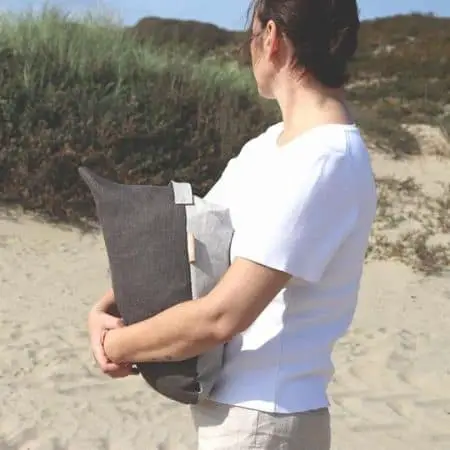
An experienced meditator or a meditation teacher will share with you that it requires many years of experience to train the body to sit still during the meditation. And it all starts with patience, practice, and experience. While meditation is far from harmful, sitting in the wrong position can be harmful over time. As a result, many physicians, yoga instructors, and meditation gurus recommend using a good quality meditation pillow.
As if the meditation community praising meditation pillows wasn’t enough, the science community has spoken up about the benefits of using a meditation pillow or a floor cushion when sitting low.
There are not too many studies conducted yet about which type or shape meditation pillow is the best for people who love to use them. However, science does emphasize the importance of maintaining a proper spine alignment while sitting on the meditation pillow (or floor cushion) either for meditating or socializing.
Why Should You Use a Meditation Pillow?
While science may not have a lot to say specifically about the meditation pillows, it does point to correct posture during meditation as a way to prevent discomfort and ergonomic injuries.
Meditation pillows are preferable to other types of pillows or cushions for meditation for the following reasons:
- They are specifically designed to elevate the pelvis.
- They are also designed to reduce and alleviate pressure on the legs, knees, and ankles.
- They are designed to support a proper posture during meditation practice.
There is a reason you’ll see meditation pillows in any Buddhist monastery or serious meditation center. Not only do meditation pillows make meditation more comfortable, but they also help a meditation beginner to develop a proper posture habit. As a result, chronic pain and discomfort is avoided.
Meditation beginners who only meditate from five to fifteen minutes at a time may not feel as much discomfort from sitting in the meditation as those who sit in mediation for much longer. However, they can still accumulate the pains of lousy posture from doing it unconsciously, incorrectly, or without spinal support.
What to Look for in a Meditation Pillow
Just like typical, everyday-use pillows, meditation pillows come in all shapes, sizes, and colors. There are millions of people who practice sitting meditation regularly, and just as each practitioner is different and unique, so is every meditation pillow.
Some pillows feature memory foam cushioning or stuffing, while others are constructed out of buckwheat hulls. Regardless of which type of pillow material you choose, there is a meditation pillow suitable for everyone.
Your Meditation Pillow’s Color
Believe it or not, the color of a meditation pillow holds some significance as well. For instance, certain colors are believed to affect a person’s mood and energy in different ways.
These are some basic colors that:
Gives tranquility:
- Blue—promotes relaxation and is associated with wisdom;
- Green—the most relaxing color for the nervous system, represents balance, stabilizes emotions;
- White – the color of well-being, calmness;
- Purple—improves balance
Convey joy:
- Pink – the color associated with love, romance, and good feeling;
- Orange—physical and mental healing energy; the color of success;
- Yellow—improves mood and intuition, the color of success
- Black—encourages deep focus.
Color therapy is scientifically proven to positively affect people, so if you would like to add a bit of enhanced personal energy to your experience, perhaps finding a meditation pillow in one of the above-listed colors is not such a bad idea. The effect of color on your energy also suggests that deeper colors provide a stronger, more powerful effect.
In addition to the color of a meditation pillow, aspects such as the following are things you should look for when buying one:
- The material/fabric
- The cushion filling
- The level of comfort
- The aspect of eco-friendliness and practicality
How to Find the Right Meditation Pillow
Once you take all the factors of a good meditation pillow into consideration, finding the right one is much easier. There is an art to sitting meditation, and it has been maintained for centuries. Although the exact origin of meditation pillows is unknown, Chinese and Japanese Zen Buddhists are believed to have had a significant influence on the art of meditation and using meditation pillows.
The ancient practitioners of meditation used woven mats made out of dried leaves and seeds to provide comfort. Over time, these mats eventually evolved into the fancy meditative cushions and pillows we see today.
Using a meditation pillow may feel strange at first, especially if you’ve never used one before, but buying the right one can lessen the chance of this happening. When you decide to purchase a meditation pillow, it’s important to think about the most important aspects to you. Some people may be more concerned with softness than material type, while others will want a color to match their meditation studio or home decor.

The majority of people consider the most important characteristics of the perfect meditation pillow to be:
- Practicality – for example, whether the pillow can be used only for meditation, or it can also nicely blend into the living room environment? How easy is it to carry the pillow around?
- Material – if the meditation pillow is used regularly, the durability of the materials that the pillow is made from plays an important role. And don’t forget the filling – the filling of the pillow will determine for how long the pillow will keep the shape;
- Eco-friendliness – lately, this aspect became very important. Is the pillow environmentally and people friendly?
- Shape – do you require lower back support while you sit in meditation? Would you like to improve your sitting posture? Or you simply look for the meditation pillow without special features?
Likewise, your preferred meditation position and the view of life is something to consider, as well. Do you prefer to sit cross-legged or in your favorite chair? Do you like sitting high up or lower? This will determine what type of meditation pillow is best suited for you.
Meditation pillows improve your posture, regardless of the type. However, asking yourself what areas of your posture need the most improvement isn’t a bad idea either. For instance, if you find that you slouch easily, even when sitting on a regular cushion, consider looking for a pillow that sits higher than a standard one.
How to Properly Use a Meditation Pillow
It’s no secret that using a meditation pillow can enhance meditation, but using it incorrectly can easily take away beautiful experience. There are ways that you can add more stress to your body by not sitting on the pillow correctly. The two most important areas you should pay attention to are where you are sitting on the pillow and how you are sitting.
It’s important to place all your weight at the center of a meditation pillow to use it correctly. This not only balances out your weight, but it also straightens out your spine. Learning how to sit on your pillow correctly and get comfortable while meditating with it may take some time. Once you get used to it, you’ll quickly forget it’s there.
One area that many meditation students forget to focus on is how they rest their legs when using a meditation pillow. Because a meditation pillow does all the work for you as far as supporting your weight and reducing the strain of sitting goes, it’s easy to forget that your lower body still requires support as well. So, you must make it a point to focus on comfort in all areas of your body.
Conclusion: Meditation Pillow Can Greatly Improve Your Meditation Practice
If you’re looking at improving your meditation practice, preventing chronic discomfort, or relieving back pain during sitting meditation practice – consider investing in a proper meditation pillow. A good meditation pillow will keep your spine aligned, provide support to your lower back, and keep your body in a proper sitting posture.
Meditation pillows can make meditation more comfortable, leading to many physical, mental, and emotional benefits backed by science.

